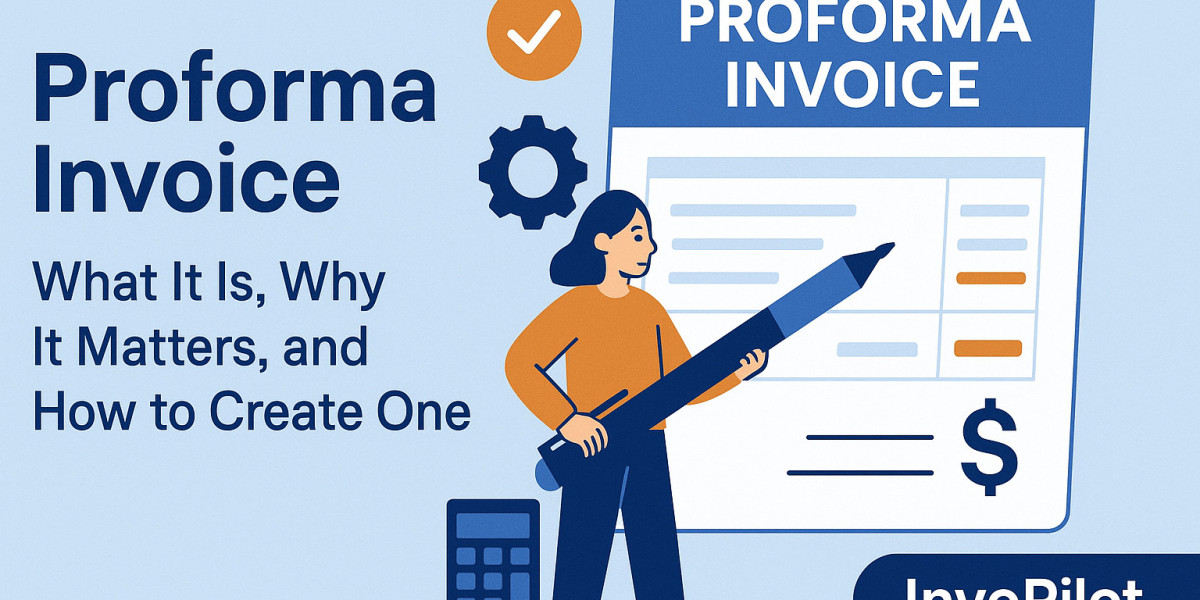In the world of trade and commerce, clear communication between buyer and seller is key. One important document that helps establish clarity before the actual transaction takes place is the Proforma Invoice.
Although it looks like a standard invoice, it serves a different purpose—it’s more of a quotation or commitment rather than a demand for payment.
In this guide, we will cover everything you need to know about proforma invoices—what they are, why they are important, how to create one, and best practices to follow.
What is a Proforma Invoice?
A Proforma Invoice is a preliminary bill of sale sent to the buyer before goods are shipped or services are delivered.
It outlines important details like:
Description of goods or services
Quantity
Price
Payment terms
Delivery terms
Taxes and other charges
Unlike a regular invoice, a proforma invoice is not a payment request—it is issued for informational purposes. The buyer uses it to review the details, estimate costs, arrange finances, and even secure import/export licenses.
? Example: If a company in India is importing machinery from Germany, the German seller will issue a proforma invoice so the Indian buyer can understand the cost, arrange payment terms, and initiate customs clearance.
Purpose of a Proforma Invoice
Proforma invoices are widely used in international trade, custom orders, and B2B transactions.
Here are the main purposes they serve:
Price Confirmation
Buyers get a clear idea of the total cost before committing to the purchase.Approval Process
Some organizations need internal approval before making purchases. A proforma invoice provides the necessary details for management sign-off.Customs Clearance
In import/export transactions, customs authorities may require a proforma invoice to assess duties and taxes before the goods arrive.Financing Arrangements
Buyers can use the document to apply for trade finance or arrange payment with their bank.Avoiding Misunderstandings
It ensures both parties are on the same page regarding the transaction details.
Difference Between Proforma Invoice and Commercial Invoice
It’s easy to confuse a proforma invoice with a commercial invoice, but they serve different purposes.
| Aspect | Proforma Invoice | Commercial Invoice |
|---|---|---|
| Purpose | Quotation / estimate before the sale | Final bill for payment after goods/services are delivered |
| Legal Status | Not legally binding | Legally binding for payment and customs |
| Payment Demand | No | Yes |
| Usage | Price confirmation, approvals, customs pre-clearance | Payment request, customs clearance |
| Timing | Before the sale is confirmed | After the sale is completed |
When Should You Use a Proforma Invoice?
You should issue a proforma invoice in situations like:
International trade before shipment to help buyers prepare import documents.
Custom orders where pricing needs confirmation before production.
Large B2B contracts where purchase approval is required.
Service agreements when scope and pricing need confirmation before starting work.
Key Elements of a Proforma Invoice
To make a proforma invoice useful and professional, it should include:
Header – Clearly state “Proforma Invoice” at the top.
Seller Details – Company name, address, contact info, tax ID.
Buyer Details – Customer’s name, address, contact info.
Invoice Number & Date – For easy tracking.
Description of Goods/Services – Detailed breakdown.
Quantity & Unit Price – Clear pricing structure.
Total Amount – Including applicable taxes and shipping charges.
Payment Terms – e.g., 50% advance, balance on delivery.
Delivery Terms – Shipping method, estimated delivery date.
Validity Period – How long the offer stands.
Company Logo – For branding and professionalism.
How to Create a Proforma Invoice – Step-by-Step
Creating a proforma invoice is simple if you follow these steps:
Choose the Right Template
Use a professional, easy-to-read template that includes all necessary fields.Add Seller and Buyer Information
Clearly mention full names, addresses, and contact details.Include Detailed Descriptions
Be specific about the goods or services to avoid confusion.List Pricing and Totals
Show unit price, quantity, and total for transparency.State Terms and Conditions
Mention payment method, delivery timeline, and validity.Review for Accuracy
Double-check all figures and spelling before sending.
? If you want a quick and professional way to create invoices, you can try free invoice generator tools available online for speed and accuracy.
Benefits of Using a Proforma Invoice
1. Improves Transparency
Both parties know exactly what to expect before the deal is finalized.
2. Speeds Up Approvals
Management can approve purchases faster with clear documentation.
3. Eases International Transactions
Customs authorities can process goods quickly with advance documentation.
4. Reduces Disputes
Clear terms and pricing reduce the chances of misunderstandings.
5. Strengthens Professionalism
Issuing formal documents shows you value professionalism in business.
Common Mistakes to Avoid
Not marking it as “Proforma Invoice” – This can cause confusion with a final invoice.
Leaving out important details – Missing payment or delivery terms can delay deals.
Incorrect pricing – Always double-check figures before sending.
No validity date – Without it, you may be bound to outdated pricing.
Proforma Invoice in International Trade
In cross-border trade, proforma invoices play a crucial role:
Helps with import licensing
Assists in customs duty calculation
Facilitates currency exchange arrangements
Provides documentation for letters of credit
For example, if an Indian buyer is importing coffee beans from Brazil, the seller sends a proforma invoice stating quantity, price, and shipping details. The buyer uses it to arrange payment through their bank before the shipment is dispatched.
How to Send a Proforma Invoice to Clients
You can send a proforma invoice:
As a PDF via email
Through cloud-based invoicing platforms
Attached in project proposal documents
For maximum professionalism, use a tool like invopilot to generate, store, and track your invoices in one place.
Best Practices for Proforma Invoices
Always keep a copy for your records.
Use consistent formatting for branding.
Keep terms clear and concise.
Send it promptly to avoid delays in transaction approvals.
Update it if any details change before confirmation.
Conclusion
A proforma invoice is not just a formality—it’s a powerful business tool for confirming terms, improving transparency, and speeding up approvals. Whether you’re dealing with local clients or international buyers, issuing a well-prepared proforma invoice sets the stage for smooth transactions.
Using digital tools to create and send proforma invoices can save you time and reduce errors. Platforms like InvoPilot offer efficient solutions for businesses of all sizes, helping you create professional documents with ease.







